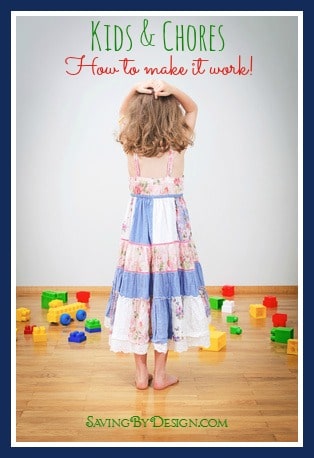
Even before my kids were born, I always knew that I wanted to raise them in a home full of love, encouragement and responsibility. And yes… some of that meant that there were definitely going to be chores handed out! When I grew up, I never had a set chore list or a weekly allowance, but I definitely was expected to get certain things done around the house, keep my space clean, and help with whatever my parents asked me to help with right when they asked. There was a bit of the “Fear of God” handed out in my house, so I knew I had to listen and stay in line if I wanted to maintain the goodwill in the house! In today’s world it’s a bit different and we’ve went the way of chore charts and visual aids to help us in grounding our children with the responsibilities they need to be accountable for. Which begs the question… When it comes to Kids and Chores – how do you make it work?
In today’s age, I’ve seen a lot of kids grow up with no concept of what money truly is and it scares me to think what the money management skills will be like in the next generation. However… we don’t pay any allowance. For now. Why? We plan to someday after there has been an engrained sense of chores that need to be done and it is age appropriate, but right now, our kids are still young. My 2-year-old just doesn’t care about that kind of stuff yet. And while my 4-year-old definitely knows what money is (and likes to tell us how to spend it in a toy store), ultimately, that isn’t his biggest concern just yet. What are his concerns? TV time. His toy cars. Legos. Bedtime. And these are the things we use to make sure he understands that he has to work to get the things he wants and these things won’t just be handed to him. How?
1. Establishing a Point System
I’ve made a “Chore Jar” in the house with age-appropriate items for my 4-year-old to accomplish in order to earn points towards things he wants to do. Want to stay up an extra 30 minutes (on weekends only)? Earn enough points from the chore jar in order to stay up. Want to play one more educational game on the iPad for 15 more minutes? Tackle some chores in the jar to earn extra points. All of the different chores have different point values assessed to them. Easy things are small point wins, while more time-consuming and difficult things are big point wins. He can also bank them up to earn a new toy, which starts to teach the concept of saving and how things don’t happen right away without some hard work involved. Yes… we have some tantrums. Yes… there has been some instances of trying to “barter” for additional things. But overall, it has been great. He knows where the jar is and while he may not be able to read the exact words yet, he has been able to get a feel for what it means when he sees a number value associated with it. Low numbers? He knows he can knock it out quickly. High numbers? They may be a little more intimidating, but he knows it’s going to be a more worthwhile reward. It’s also helped to splash some sight words into the chore labels!
2. Chore Charts
Since our kids don’t read yet, I’ve made a very simple chart containing things that are mainly aimed at my 4-year-old (since my 2-year-old isn’t in an age appropriate category for most of these items) and I’ve cut out pictures describing the chore that needs to be done. Mostly, I find things on the internet or in magazines that replicate what I’m aiming at having him accomplish and I have things broken out by days of the week. Since he’s learning his days of the week and months in school right now, it’s been a perfect educational tool, as well. He sees the items he needs to do that day, he sees what the day of the week is right away in the morning, and he’s on his way. Even things like brushing teeth, combing hair, putting coats away, etc. are on the chart in order to establish a good daily routine. Some of these things may not necessarily be “chores” but it does help to promote responsibility.
3. A Daily Behavior/Consequence Chart
This is something that we started awhile ago and will probably start implementing with our youngest soon. I made up a very simple chart that looks something like this that I found on Pinterest a year or so back. I can’t tell you how great this has been to make sure everyone is staying on task during the day. Starting out on top every morning is easy enough, but it’s the behavior that is displayed throughout the day that determines if the smiley face remains by the end of the night. If it does? Points are added to earn rights, which were discussed above. If not? It could lead to an early bedtime or a loss of a favorite toy. It has really helped my little guy stay on task during the day to do what he is being told, while seeing a visual reminder. Once he is skating on thin ice and I start heading over to the chart? His tune changes quickly because he knows he’ll lose rights or may even be punished if the behavior continues.
Now when it does become age-appropriate, we intend to offer an allowance for chores done around the house. However, not ALL chores.
1. We plan to have chores that HAVE to be done before anything else. These will comprise of things that they need to have done around the house no matter what. Think… cleaning their rooms, helping to dust and vacuum the house, helping with dishes, etc. And these kinds of things will be UNPAID. Wha-wha-what?!?! Yup. These are items that will teach them accountability and consequences. They won’t get paid for it, because these are things that we will expect them to do.
2. There will than be a list of chores that can be done around the house and yard that will be paid and will change depending on what needs to be done on any given day. Maybe it’s to help mom wash the car. Or help dad do yard work. Things above and beyond that will help to give them a sense of what it feels like to earn money and be responsible for it. We want our kids to learn real life skills and teach them the importance of saving and how to spend their money responsibly. It’s one of the reasons we let points get banked from the chore jar. It’s the “beginners” version of an actual savings account where they can save what they have.
Obviously, time will tell as our kids age and we see how they handle the different things that come their way. Our main purpose is to help teach them responsibility and to instill a strong work ethic. Many things in life HAVE to get done in order to be a functioning member of society, like it or not. Everyone has different things that will work for their own families, but these rules seem to be working well for our kids with getting a chore system established. It’s an evolving thing that I’m sure we’ll change and grow as the kids’ ages advance, but I love knowing that we’re doing what we can to make them polite, responsible, and accountable for the things they do or don’t do!
Do you have a system worked out with your children on how to complete chores around the house that works well? Share tips below in the comments and give us your secrets! 🙂






Leave a Reply